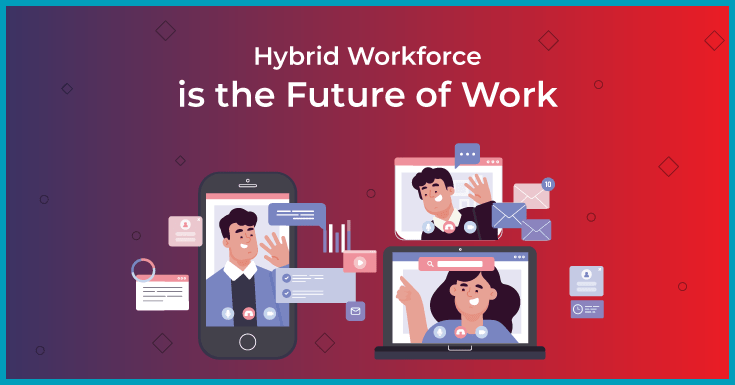The concept of a hybrid workforce isn’t new, but its adoption has definitely risen in line with businesses exploring flexible work options. In the interest of heeding public safety guidelines, businesses are reopening cautiously. Employees in some companies are following the 70/30 rule that has them reporting to the office as well as choosing when to work from home.
Even with mass-vaccination programs, both employers and employees alike are starting to see the upside to workplace hybridity. Choosing how and where to work allows employees the opportunity to integrate work into their lives. It increases autonomy and self-discipline while letting businesses tap into the power of automation and real-world skills.
A Gartner report reveals that 48% of the workforce will continue to work remotely in a post-pandemic world. Cultivating a flexible workplace is an imperfect science, but one thing is certain- the hybrid workforce is here to stay.
In this post, we’ll look at what a hybrid workforce is and the critical success factors to nurturing one to evolve for the future.
- 1. What is a Hybrid Workforce?
- 2. What is the Difference Between Remote and Hybrid workforce?
- 3. Hybrid Working Model Post COVID
- 4. What is a hybrid work schedule?4.1 Use flexible desking
- 4.2 Make hybridity interactive
- 4.3 Install video conferencing on systems
- 5. The Benefits of Hybrid Working5.1 Prioritizes employee well-being
- 5.2. Increases adoption and ease with digitization
- 5.3 Access to a wider talent pool
- 5.4 Reduced operational costs
- 5.5 Increased flexibility
- 6. Disadvantages of hybrid working6.1 Decline in customer service satisfaction levels
- 6.2 Increased bouts of loneliness
- 6.3 Security breaches
- 6.4 Lack of democratization
- 6.5 Skewed Performance Appraisals
- 7. The Bottomline- Hybrid Work Environment
1. What is a Hybrid Workforce?
The hybrid workforce refers to a model of working where employees carry out office work both remotely and at a physical workspace. The office is used as a business center where employees occasionally drop in to collaborate on projects.
A hybrid workforce brings every employee onto a unified scale of flexibility, whether they are full-timers or freelancers. It enables workers to move between various work sites- from remote locations (including their homes) and microsites like co-working spaces to full-scale offices and industrial plants. The focus is on getting work done in a place that makes optimal use of their productivity and engagement.
2. What is the Difference Between a Remote and Hybrid Workforce?
The advent of flex-work has resulted in different types of distributed workers. Hybrid work arrangements enable employers to offer both existing and potential hires the flexibility to work wherever they are comfortable. The differences between remote and hybrid workforce are as follows;
Remote Workforce | Hybrid Workforce |
1.Nature of WorkplaceRemote employees work remotely, either full-time or to some extent. They can opt to work out of the same place all year long, or move around as a digital nomad. | 1. Nature of WorkplaceA hybrid workforce can choose to work wherever they are most productive. The hybrid team comprises colleagues that are divided between home locations and a fixed office location in the same geography. Put simply, some employees opt to work away from the office, while conferencing in with their collocated counterparts |
2. ExperienceWorking remotely is experience-independent, i.e. you need not have prior experience and can be a recent workforce entrant or a seasoned professional. | 2. ExperienceHybrid workforce works better with experienced staff,i.e. Members who aren’t new to the concept of dividing their time and schedule across remote and office locations. |
3. Workplace locationRemote employees can be anywhere, either in the same location as where the office is or in a different country. Not everyone can report for duty in-person. In such cases, everything is done virtually, from hiring and onboarding to appraising work. | 3. Workplace locationMembers working outside of the office may be required to come in occasionally for critical meetings, peer-reviews or appraisals. It is transitional in nature, enabling businesses to explore the concept of remote work before taking the plunge. |
4. CommunicationInteractions are online using both asynchronous and synchronous means of communication such as collaboration tools, email, video conferencing, and messaging apps. | 4. CommunicationInteractions are both online and onsite. Members in the same office can hold face-to-face meetings and conference-in with their remote counterparts to recreate watercooler hangouts and work discussions. Meetings are scheduled for an hour that works for both onsite and virtual members. |
5.Conducting Company RetreatsRemote companies have the option to rent a physical venue for yearly retreats even if they don’t have an operational head office. They can fly in those remote workers who are in different locations. | 5. Conducting Company RetreatsRetreats can be either conducted in-person with everyone in attendance or partially online. It's just that the ratio of online to onsite delegates vary from business to business. |
3. Hybrid Working Model Post COVID
One of the lasting effects of the COVID-19 pandemic is the way we work.
According to a Stanford study released in June 2020, 55% of US workers want to divide their time between home and the office. Employers in the UK have estimated the proportion of regular remote workers to double from 18% pre-pandemic to 37% post-pandemic. And in India, a post-Covid survey reports that 33.44% of the participants prefer adopting hybrid models for office while only 27% prefer going back to a physical office.
I know I just hit you with a lot of stats. But here’s the deal; most employees have become accustomed to what was originally intended as a makeshift arrangement. This presents a problem for businesses that were previously unused to remote work.
While some companies, particularly tech mammoths like Facebook and Apple, have given their employees the option to work remotely till July 2021, others have reopened offices to some capacity by staggering groups. There are companies that are implementing shifts to minimize contact for collocated workers, or leaving it to their employees to decide their home and office time. The trouble is, such measures invite added expenses for those workers who moved back home to save on rent. They would have to spend considerable time, effort, and money to find a new place to live, all the while wondering if the move is worth it. In extreme cases, they may even resign in favor of a company offering indefinite work-from-anywhere.
This is why businesses should consider the impact such disparate measures have on the future of work. Consistency is key to implementing a hybrid workforce model. It should offer employees the freedom to work and commute as they see fit. There should be a system for conveying in advance those days that employees are expected to show up in person. On a related note, workers should also inform their superiors of the number of days (or hours) per month that they wish to work away from the office. This gives the workforce the liberty to create a comfortable and productive workspace. They have greater autonomy to structure work around their lifestyle. They can also remain accountable for their results, rather than be measured by their presence.
Hybrid workplaces are ideally the best of both worlds: you can socialize with coworkers both online and onsite while gaining greater control over your work environment.
4. What is a Hybrid Work Schedule?
A hybrid work schedule refers to how staff divides their scheduled work hours between the office and home. The widely accepted standard for a hybrid work schedule is 51% of company time at-office and 49% in remote work or work-from-home (WFH).
Both the company and its staff reach a consensus on the tasks or functions that require the latter to report to a physical office. This varies from person to person and depends on the nature of the work. In the interest of ensuring that everyone avails the opportunity to work remotely, hybrid workers take shifts. Here are some tips to stick to a hybrid work schedule:
4.1 Use flexible desking
Flexible desking is the practice of employees booking in-office workstations or computer terminals. Bookings reserve systems for employees instead of powering them at the same time. You can also optimize the usage of lighting, entry, and exit points in order to save utility bills.
Flex-desks ensure employees have access to important files stored on work devices. They can use equipment (such as monitors) as and when required without having to lug it back and forth or ending up getting stuck with it.
4.2 Make hybridity interactive
You can create an interactive digital floor plan or office roster so that hybrid workers can find their way around more easily. If you have the time and room for creativity, you can even label workstations or color code shifts to make it easier for employees to know who all are coming in for that week. This is called pathfinding (or wayfinding) and makes workers feel more included and organized.
4.3 Install video conferencing on systems
Reserved devices should have video conferencing platforms pre-downloaded and set up so that in-person teams can hit the ground running. It makes sure everyone makes it on time to scheduled meetings and keeps discussions on-track.
5. Benefits of Hybrid Working
The benefits of hybrid working are, that it;
5.1 Prioritizes employee well-being
Employees have the flexibility to choose when to come in and which days to designate as ‘remote’ days, ensuring that they can work in an environment that aids in their productivity without compromising well-being. In light of the virality of infections, employees can minimize the chances of contracting any illnesses through limited excursions.
5.2 Increases adoption and ease with digitization
Employees can switch between mobile and desks to stay in touch with colleagues. Those workers whose work is manually-intensive can gradually ease into digitization by familiarizing themselves with tools that automate such work.
They become well-versed with different platforms and find themselves freed up to devote more time towards utilizing their creative thinking, strategic planning, and decision-making skills.
5.3 Access to a wider talent pool
You can plug skill shortages and fast-track the lead time to hire by moving their processes online. The internet is filled with job sites that provide you access to a potential applicant’s profile. This lets you determine if they and you are a mutually good fit.
Having a diverse talent pool can also be beneficial in managing clients across the globe. For example, polyglots who are in customer-facing and account management roles can introduce your services to an audience in a different location, thus increasing your leads.
5.4 Reduced operational costs
You can downsize and economize the office space according to the footfall. Hybrid work arrangements mean that you won’t need all your employees at once, and thus save approximately 20% on real-estate and your usage of resources.
5.5 Increased flexibility
Not having to report every day to a physical office gives employees the opportunity to recharge and unplug from the comfort of their home surroundings. They can determine their window of productivity during which time they are more efficient.
This helps them carry out work without the quality suffering. What’s more, they can be around more for their family. An employee who is able to balance both work and personal commitments is more satisfied and therefore more likely to perform well and succeed.
6. Disadvantages of Hybrid Working
Like any other model of working, hybrid working isn’t exactly flawless. The downsides include:
6.1 Decline in customer service satisfaction levels
It's hard for remote and hybrid companies to establish their credibility. This is because clients more readily trust companies that are visibly staffed. The resulting hesitation and mistrust can cause a decline in satisfaction levels. Customers are concerned that their feedback or grievances may not be seen, let alone responded to.
Worse, a hybrid staff can make taking over account management harder, given that the team comprises a mix of virtual and in-office members. Technology and social media can mitigate this to some extent. Companies can create a team to respond to feedback left online so that customers know that the company they’re doing business with is paying attention.
6.2 Increased bouts of loneliness
If there’s a long gap between coming into work and staying home, employees can feel isolated and siloed from the rest of the workforce. The camaraderie dilutes over time, causing some employees to be left out of inside stories, jokes, and discussions unintentionally. Standardizing communication and setting aside time for banter and a friendly catch-up can help employers check-in on hybrid employees.
6.3 Security breaches
If your work policy allows for BYOD and work devices, you should also consider the risk of security threats. If any or some devices use outdated protection, it can lead to outsiders getting access to sensitive information.
Companies will need to preempt such risks by running security checks on all devices. They can also use employee monitoring software to ensure that websites and applications being accessed are logged. Suspicious activities can be consequently flagged and blocked to deter repeat visits.
6.4 Lack of Democratization
No matter where employees are, they should all be included, informed, and involved in decisions impacting the business and their growth. In a hybrid setup, employers find it difficult to democratize this process due to everyone not being in the same location at the same time.
Staying organized is important to democratizing decisions. It lets you keep track of schedule rotations so that you know which means of communication to leverage to keep everyone in the loop.
6.5 Skewed Performance Appraisals
Since offices are also a center for information, it's easier to verify what workers are on when they spend more time at the office than away from it. The risk here is that managers tend to form a bias when appraising work performance.
This downside can be combated by setting performance metrics by the employees’ role, skills acquired, versatility, number of years of service, and previous contributions. This way, appraisals bring out a person’s strengths and areas to improve upon.
7. The Hybrid Work Environment
The hybrid workforce can succeed if companies are intentionally inclusive. Such a set-up not only mobilizes talent but also enables companies to get the best out of their workforce.
Businesses that are considering adopting the hybrid workforce model have to take into consideration how much time and effort they can invest in standardizing tools for communication, schedule and time management, cybersecurity, and knowledge sharing.
When done right, hybrid working can create employee experiences that impact your brand positively. It could take another year for things to return to the way they were before the pandemic, and this is a conservative estimate. Going hybrid may prove to be the best way for employers to retain top talent, and for employees to progress in their careers.
Considering hybridity at work? Fill us in on your thoughts!
 Interested in Virtual Team Building Events?
Interested in Virtual Team Building Events?




























